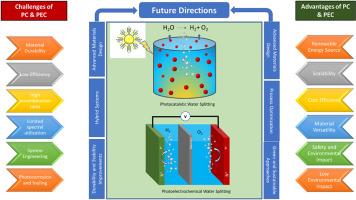太阳能驱动的光催化和光电催化析氢反应:进展、挑战和未来方向
IF 8.3
2区 工程技术
Q1 CHEMISTRY, PHYSICAL
引用次数: 0
摘要
太阳能制氢是一种潜在可行的解决方案,可以解决由化石燃料燃烧引起的气候变化,同时利用太阳能。光催化、光电化学、光电电化学、太阳热化学、光热催化和光生物学是目前研究最广泛的太阳能制氢方法。在所有已开发的策略中,光催化(PC)和光电催化(PEC)系统由于可以利用太阳能生产化学燃料而受到高度认可。本文评述了半导体材料特别是异质结构体系在优化析氢反应(HER)方面的最新进展。我们分类并讨论了传统异质结、Z-scheme和S-scheme结构、等离子体纳米复合材料和石墨氮化碳(g-C3N4)功能化在增强可见光吸收、电荷分离和氧化还原电位匹配方面的功能。它还指出了当前的挑战,包括低太阳能制氢效率和材料可扩展性,并概述了推进高效、稳定和可扩展的制氢系统的未来方向。这篇综述旨在给研究人员一个全面的和最新的概述设计下一代光催化剂和混合系统的太阳能制氢。本文章由计算机程序翻译,如有差异,请以英文原文为准。

Solar-driven photocatalytic and photoelectrocatalytic hydrogen evolution reaction: Advances, challenges, and future directions
Solar hydrogen production is a potentially viable solution to the climate change caused by the burning of fossil fuels, in along with the utilization of solar energy. Photocatalysis, photoelectrochemistry, photovoltaic-electrochemistry, solar thermochemistry, photothermal catalysis, and photobiology are the most extensively researched methods for the production of solar hydrogen. Among all the developed strategies, photocatalytic (PC) and photoelectrocatalytic (PEC) systems are highly recognized because they can utilize solar energy to produce chemical fuels. This review critically analyzes recent progress in semiconductor materials specifically heterostructured systems in optimizing hydrogen evolution reactions (HER). We classify and discuss the function of conventional heterojunctions, Z-scheme and S-scheme structures, plasmonic nanocomposites, and graphitic carbon nitride (g-C3N4) functionalization in enhancing visible-light absorption, charge separation, and redox potential matching. It also pinpoints the current challenges, including low solar-to-hydrogen efficiency and material scalability, and outline future directions for advancing efficient, stable, and scalable hydrogen production systems. This review seeks to give researchers a comprehensive and up-to-date overview of designing next-generation photocatalysts and hybrid systems for solar hydrogen production.
求助全文
通过发布文献求助,成功后即可免费获取论文全文。
去求助
来源期刊

International Journal of Hydrogen Energy
工程技术-环境科学
CiteScore
13.50
自引率
25.00%
发文量
3502
审稿时长
60 days
期刊介绍:
The objective of the International Journal of Hydrogen Energy is to facilitate the exchange of new ideas, technological advancements, and research findings in the field of Hydrogen Energy among scientists and engineers worldwide. This journal showcases original research, both analytical and experimental, covering various aspects of Hydrogen Energy. These include production, storage, transmission, utilization, enabling technologies, environmental impact, economic considerations, and global perspectives on hydrogen and its carriers such as NH3, CH4, alcohols, etc.
The utilization aspect encompasses various methods such as thermochemical (combustion), photochemical, electrochemical (fuel cells), and nuclear conversion of hydrogen, hydrogen isotopes, and hydrogen carriers into thermal, mechanical, and electrical energies. The applications of these energies can be found in transportation (including aerospace), industrial, commercial, and residential sectors.
 求助内容:
求助内容: 应助结果提醒方式:
应助结果提醒方式:


